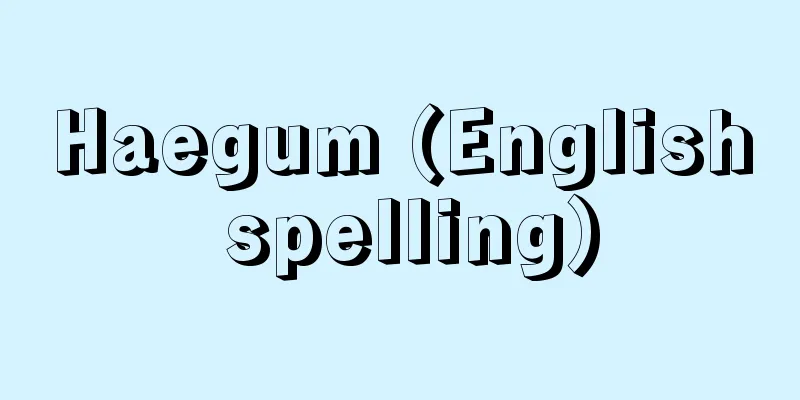Tanaka Hide - Tanaka Hide

|
Year of death: 16 September 1847 (24 October 1847) Year of birth: 28 August 1777 (29 September 1777) A scholar of Japanese classics in the late Edo period. He was the third son of Tanaka Yabei Hiromichi, a drug merchant from Takayama, Hida Province (Takayama City, Gifu Prefecture), and his wife Tomiko. He was commonly known as Yajiro or Yabei. His name was originally Kibun, later Taishu, Hachigatsu Mitsuru, and his pen names were Chikusa-en, Yutsu Koboku-en, and Eno-o. In 1797 (Kansei 9), at the age of 21, he studied waka and Japanese classics under Awata Tomochika, a shrine official at Atsuta Shrine in Owari. In 1801 (Kansei 1), he accompanied Tomochika to Tokyo and participated in the poetry gatherings of the Reizei family. In the same year, he became a student of Ban Kokei, and in 1801 (Kyowa 1), he visited Motoori Ohira in Ise, where he met Motoori Norinaga, who was in Tokyo, and became his student (April 13). In 1804, he went to Matsusaka and spent two months copying Norinaga's posthumous writings, showing his devotion to Norinaga's studies. He excelled in research into medieval literature, and his "Taketori Okina Monogatari Kai" (1831) is an extremely important work in the history of commentaries on the Tale of the Bamboo Cutter. He also determined that the location of "Inakimori" was Enami Shrine in Hida Province, and launched a movement to revive the shrine, using this as a base to work toward the development of Hida classical Japanese studies. His disciples included Adachi Inanao and Tachibana Akebono. <References> "Tanaka Daishu," edited by the Matsumuro Society; "Research into Classical Studies at the End of the Tokugawa Period," by Haga Noboru (Yoichi Iikura) Source: Asahi Japanese Historical Biography: Asahi Shimbun Publications Inc. About Asahi Japanese Historical Biography |
|
没年:弘化4.9.16(1847.10.24) 生年:安永6.8.28(1777.9.29) 江戸後期の国学者。飛騨国高山(岐阜県高山市)の薬種商田中弥兵衛博道,妻富子の3男。通称弥次郎,弥兵衛。名は初め紀文,のち大秀,八月満,号は千種園,湯津香木園,荏野翁。寛政9(1797)年,21歳のとき尾張熱田神宮祠官粟田知周に和歌国学を学んだ。11年には知周に伴われて上京し冷泉家の歌会に列した。同年伴蒿蹊に入門,享和1(1801)年には伊勢の本居大平を訪ね,上京中の本居宣長に会って入門した(4月13日)。4年,松坂に行き,宣長の遺著を2カ月にわたって写すなど,宣長学への傾倒がみられる。中古文学の研究にすぐれ,特に『竹取翁物語解』(1831)は竹取物語注釈史上きわめて重要な著作である。また「稲置森」の考証から飛騨国荏名神社をその地と定め,同社の再興運動を行い,ここを根拠として飛騨国学の発展に努めた。門人に足立稲直,橘曙覧らがいる。<参考文献>松室会編『田中大秀』,芳賀登『幕末国学の研究』 (飯倉洋一) 出典 朝日日本歴史人物事典:(株)朝日新聞出版朝日日本歴史人物事典について 情報 |
>>: Tanaka Oudou - Tanaka Oudou
Recommend
Envious
...A fortune teller of the lower class who was ac...
Rebellionism - Ikkishugi
It usually refers to the revolutionary theory (Bla...
Theologiae ancilla (handmaiden of theology)
In medieval scholasticism, this term refers to the...
Braconidae
...General term for insects belonging to the fami...
Shimi (silverfish) - Shimi (English spelling) silverfish
A general term for insects belonging to the order ...
Kyogen Furyu
...Especially after the Onin War, Noh plays such ...
Olistome
...This is an underwater landslide caused by a sl...
Gradation - Kaichou
The number of shades of color or brightness. It is...
epidēmos (English spelling)
… [Ippei Fujimori] [Epidemic and Civilization] In...
Picture and text belt circular milk god beast mirror - Gamon Taikanjo Nyuushinjukyo
...The main image in the inner section is a monst...
Pthirus
...The Neolinognathidae family is a special kind ...
Fatwa (English spelling)〈Arabic〉fatwā
Opinions and judgments issued by Islamic jurists f...
Quiet seat - Kanin no Seki
This tea room is built into a shoin study behind ...
Aidra - Eidora
…He inherited the theory of Democritus and took t...
Crested Bowerbirds - Crested Bowerbirds
…Similar breeding behavior is also known in the S...









